Abstract
Two related zinc finger (ZNF) gene clusters from the pericentromeric region of human chromosome 10, defined by cDNAs of the KOX series, have been cloned in yeast artificial chromosomes (YACs). The two clusters evolved by duplication of an ancestral gene cluster before the divergence of the human and great ape lineages. Included in cluster A are the ZNF gene sequences ZNF11A, ZNF33A, and ZNF37A, while cluster B comprises the related sequences ZNF11B, ZNF33B and ZNF37B. Genes from both clusters are expressed: cDNAs KOX2, KOX31 and KOX21 derive from ZNF11B, ZNF33A and ZNF37A, respectively. Further YACs have been isolated which link ZNF11A and ZNF33A to another gene, ZNF25, defined by cDNA clone KOX19. Therefore ZNF25 also forms part of cluster A, but has no counterpart in cluster B. Surprisingly, the KOX ZNF gene clusters are located on opposite sides of the centromere: cluster A maps to 10p11.2, while cluster B is in 10q11.2. This suggests the occurrence during primate evolution of a previously undescribed pericentric inversion subsequent to the cluster duplication. The evolution of this subset of KOX ZNF genes has therefore involved three types of genetic event: local gene duplication, gene cluster duplication, and chromosome rearrangement.
Full text
PDF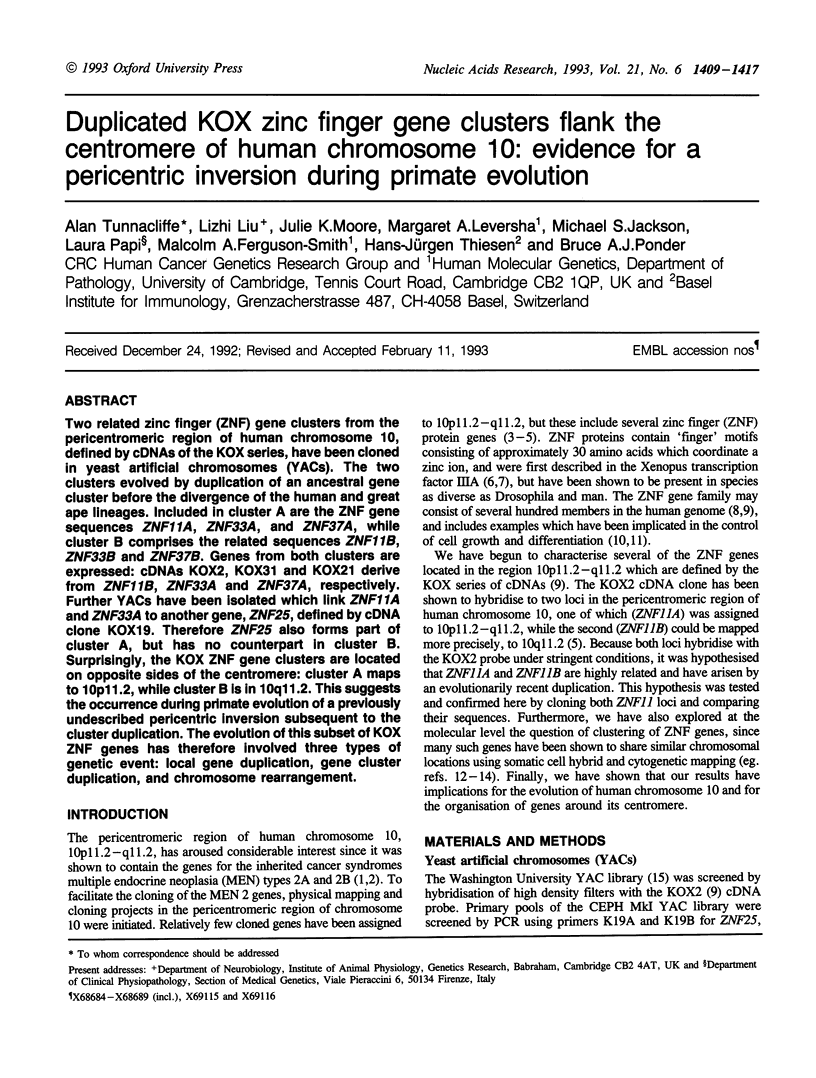
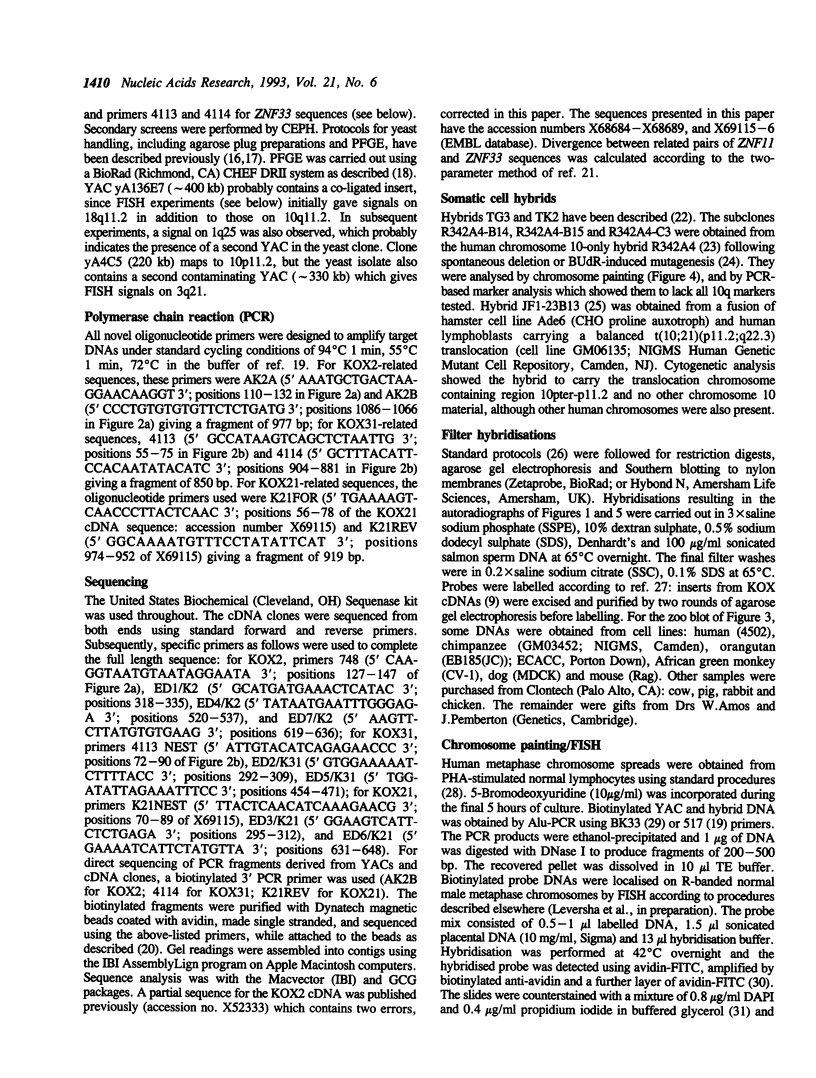


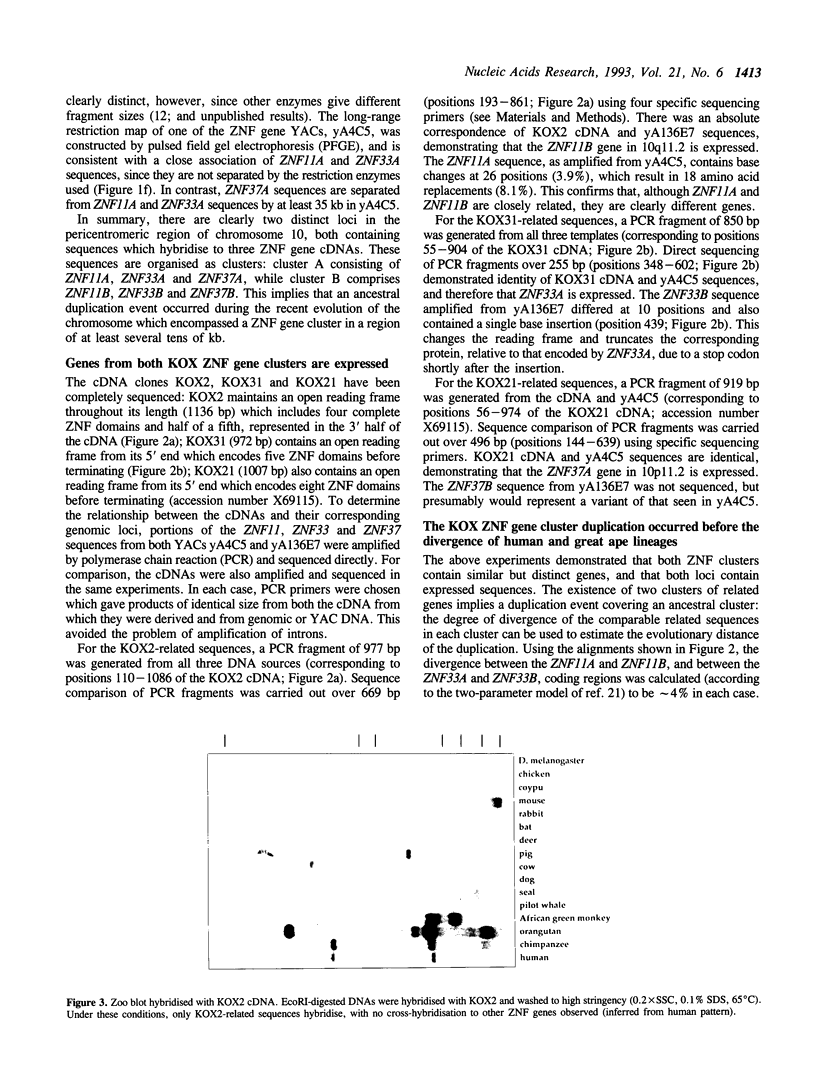

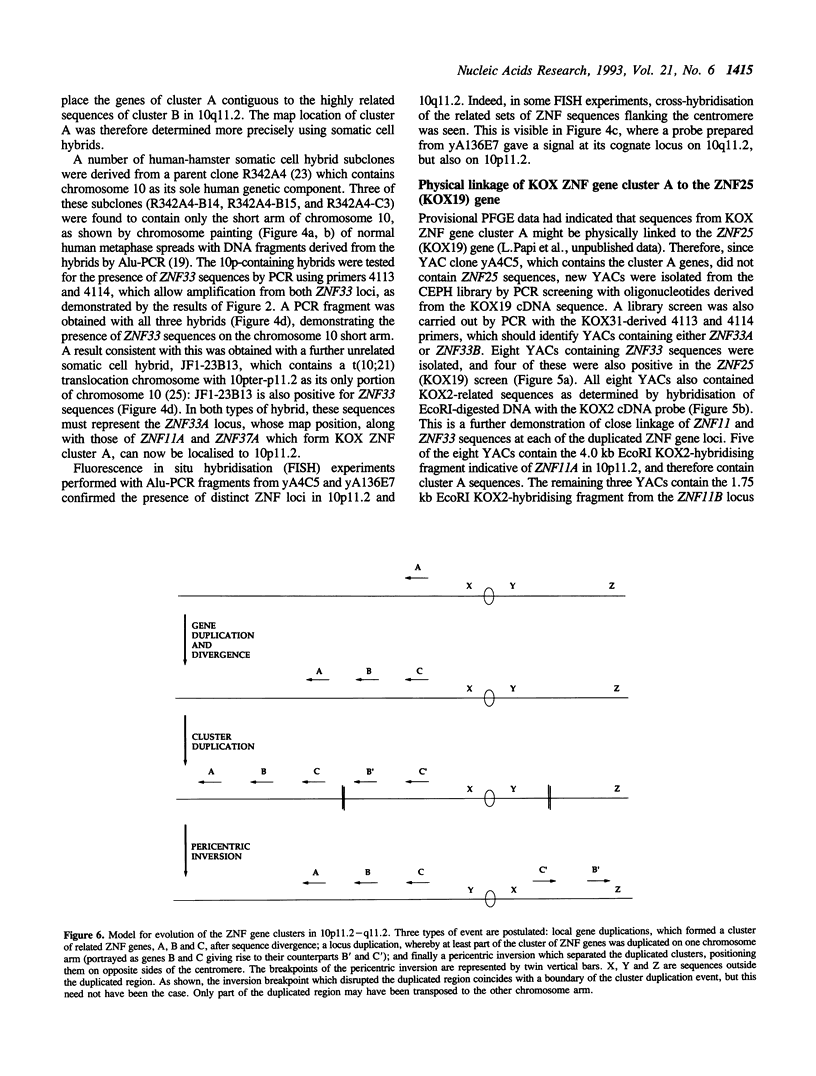
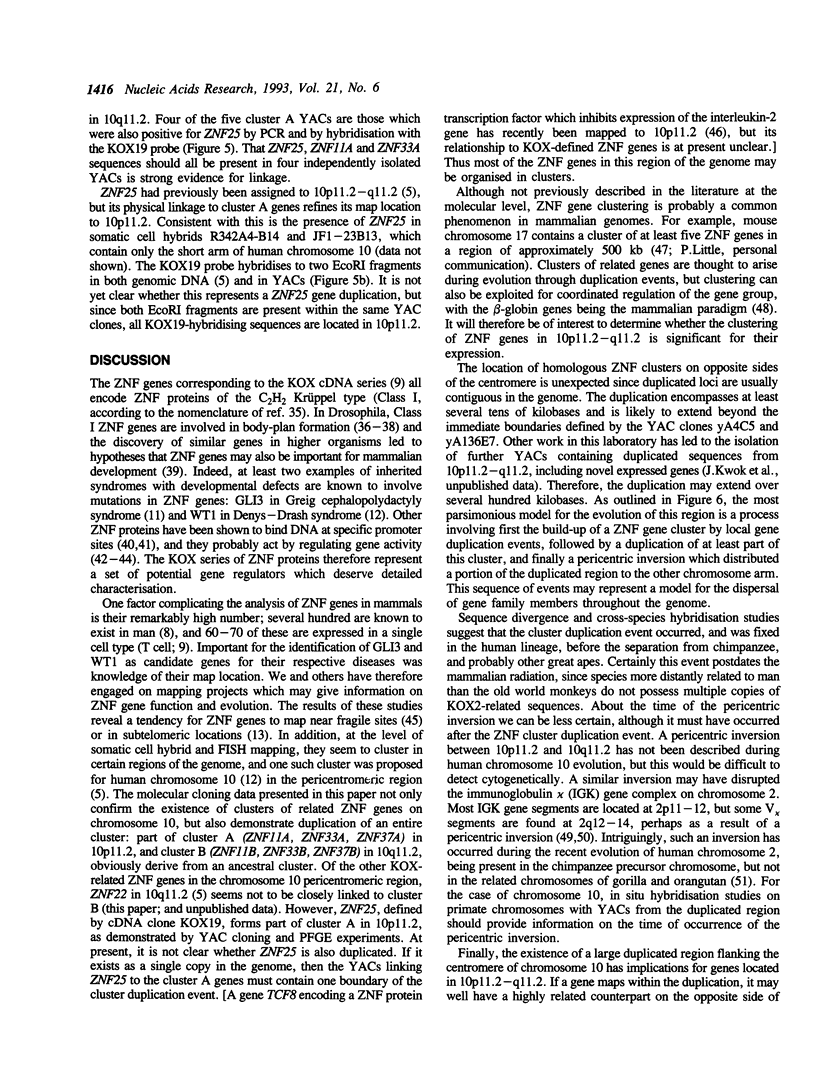
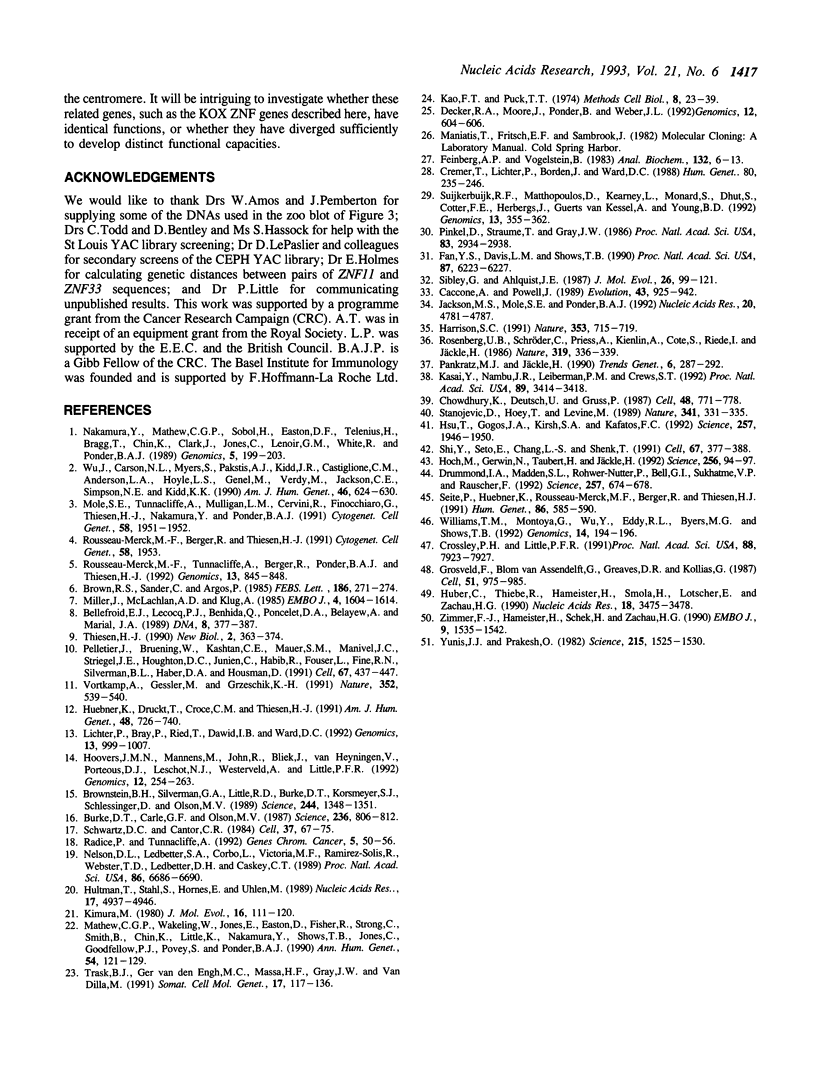
Images in this article
Selected References
These references are in PubMed. This may not be the complete list of references from this article.
- Bellefroid E. J., Lecocq P. J., Benhida A., Poncelet D. A., Belayew A., Martial J. A. The human genome contains hundreds of genes coding for finger proteins of the Krüppel type. DNA. 1989 Jul-Aug;8(6):377–387. doi: 10.1089/dna.1.1989.8.377. [DOI] [PubMed] [Google Scholar]
- Brown R. S., Sander C., Argos P. The primary structure of transcription factor TFIIIA has 12 consecutive repeats. FEBS Lett. 1985 Jul 8;186(2):271–274. doi: 10.1016/0014-5793(85)80723-7. [DOI] [PubMed] [Google Scholar]
- Brownstein B. H., Silverman G. A., Little R. D., Burke D. T., Korsmeyer S. J., Schlessinger D., Olson M. V. Isolation of single-copy human genes from a library of yeast artificial chromosome clones. Science. 1989 Jun 16;244(4910):1348–1351. doi: 10.1126/science.2544027. [DOI] [PubMed] [Google Scholar]
- Burke D. T., Carle G. F., Olson M. V. Cloning of large segments of exogenous DNA into yeast by means of artificial chromosome vectors. Science. 1987 May 15;236(4803):806–812. doi: 10.1126/science.3033825. [DOI] [PubMed] [Google Scholar]
- Chowdhury K., Deutsch U., Gruss P. A multigene family encoding several "finger" structures is present and differentially active in mammalian genomes. Cell. 1987 Mar 13;48(5):771–778. doi: 10.1016/0092-8674(87)90074-2. [DOI] [PubMed] [Google Scholar]
- Cremer T., Lichter P., Borden J., Ward D. C., Manuelidis L. Detection of chromosome aberrations in metaphase and interphase tumor cells by in situ hybridization using chromosome-specific library probes. Hum Genet. 1988 Nov;80(3):235–246. doi: 10.1007/BF01790091. [DOI] [PubMed] [Google Scholar]
- Crossley P. H., Little P. F. A cluster of related zinc finger protein genes is deleted in the mouse embryonic lethal mutation tw18. Proc Natl Acad Sci U S A. 1991 Sep 15;88(18):7923–7927. doi: 10.1073/pnas.88.18.7923. [DOI] [PMC free article] [PubMed] [Google Scholar]
- Decker R. A., Moore J., Ponder B., Weber J. L. Linkage mapping of human chromosome 10 microsatellite polymorphisms. Genomics. 1992 Mar;12(3):604–606. doi: 10.1016/0888-7543(92)90455-2. [DOI] [PubMed] [Google Scholar]
- Drummond I. A., Madden S. L., Rohwer-Nutter P., Bell G. I., Sukhatme V. P., Rauscher F. J., 3rd Repression of the insulin-like growth factor II gene by the Wilms tumor suppressor WT1. Science. 1992 Jul 31;257(5070):674–678. doi: 10.1126/science.1323141. [DOI] [PubMed] [Google Scholar]
- Fan Y. S., Davis L. M., Shows T. B. Mapping small DNA sequences by fluorescence in situ hybridization directly on banded metaphase chromosomes. Proc Natl Acad Sci U S A. 1990 Aug;87(16):6223–6227. doi: 10.1073/pnas.87.16.6223. [DOI] [PMC free article] [PubMed] [Google Scholar]
- Feinberg A. P., Vogelstein B. A technique for radiolabeling DNA restriction endonuclease fragments to high specific activity. Anal Biochem. 1983 Jul 1;132(1):6–13. doi: 10.1016/0003-2697(83)90418-9. [DOI] [PubMed] [Google Scholar]
- Grosveld F., van Assendelft G. B., Greaves D. R., Kollias G. Position-independent, high-level expression of the human beta-globin gene in transgenic mice. Cell. 1987 Dec 24;51(6):975–985. doi: 10.1016/0092-8674(87)90584-8. [DOI] [PubMed] [Google Scholar]
- Harrison S. C. A structural taxonomy of DNA-binding domains. Nature. 1991 Oct 24;353(6346):715–719. doi: 10.1038/353715a0. [DOI] [PubMed] [Google Scholar]
- Hoch M., Gerwin N., Taubert H., Jäckle H. Competition for overlapping sites in the regulatory region of the Drosophila gene Krüppel. Science. 1992 Apr 3;256(5053):94–97. doi: 10.1126/science.1348871. [DOI] [PubMed] [Google Scholar]
- Hoovers J. M., Mannens M., John R., Bliek J., van Heyningen V., Porteous D. J., Leschot N. J., Westerveld A., Little P. F. High-resolution localization of 69 potential human zinc finger protein genes: a number are clustered. Genomics. 1992 Feb;12(2):254–263. doi: 10.1016/0888-7543(92)90372-y. [DOI] [PubMed] [Google Scholar]
- Hsu T., Gogos J. A., Kirsh S. A., Kafatos F. C. Multiple zinc finger forms resulting from developmentally regulated alternative splicing of a transcription factor gene. Science. 1992 Sep 25;257(5078):1946–1950. doi: 10.1126/science.1411512. [DOI] [PubMed] [Google Scholar]
- Huber C., Thiebe R., Hameister H., Smola H., Lötscher E., Zachau H. G. A human immunoglobulin kappa orphon without sequence defects may be the product of a pericentric inversion. Nucleic Acids Res. 1990 Jun 25;18(12):3475–3478. doi: 10.1093/nar/18.12.3475. [DOI] [PMC free article] [PubMed] [Google Scholar]
- Huebner K., Druck T., Croce C. M., Thiesen H. J. Twenty-seven nonoverlapping zinc finger cDNAs from human T cells map to nine different chromosomes with apparent clustering. Am J Hum Genet. 1991 Apr;48(4):726–740. [PMC free article] [PubMed] [Google Scholar]
- Hultman T., Ståhl S., Hornes E., Uhlén M. Direct solid phase sequencing of genomic and plasmid DNA using magnetic beads as solid support. Nucleic Acids Res. 1989 Jul 11;17(13):4937–4946. doi: 10.1093/nar/17.13.4937. [DOI] [PMC free article] [PubMed] [Google Scholar]
- Jackson M. S., Mole S. E., Ponder B. A. Characterisation of a boundary between satellite III and alphoid sequences on human chromosome 10. Nucleic Acids Res. 1992 Sep 25;20(18):4781–4787. doi: 10.1093/nar/20.18.4781. [DOI] [PMC free article] [PubMed] [Google Scholar]
- Kao F. T., Puck T. T. Induction and isolation of auxotrophic mutants in mammalian cells. Methods Cell Biol. 1974;8(0):23–39. doi: 10.1016/s0091-679x(08)60441-0. [DOI] [PubMed] [Google Scholar]
- Kasai Y., Nambu J. R., Lieberman P. M., Crews S. T. Dorsal-ventral patterning in Drosophila: DNA binding of snail protein to the single-minded gene. Proc Natl Acad Sci U S A. 1992 Apr 15;89(8):3414–3418. doi: 10.1073/pnas.89.8.3414. [DOI] [PMC free article] [PubMed] [Google Scholar]
- Kimura M. A simple method for estimating evolutionary rates of base substitutions through comparative studies of nucleotide sequences. J Mol Evol. 1980 Dec;16(2):111–120. doi: 10.1007/BF01731581. [DOI] [PubMed] [Google Scholar]
- Lichter P., Bray P., Ried T., Dawid I. B., Ward D. C. Clustering of C2-H2 zinc finger motif sequences within telomeric and fragile site regions of human chromosomes. Genomics. 1992 Aug;13(4):999–1007. doi: 10.1016/0888-7543(92)90013-i. [DOI] [PubMed] [Google Scholar]
- Mathew C. G., Wakeling W., Jones E., Easton D., Fisher R., Strong C., Smith B., Chin K., Little P., Nakamura Y. Regional localization of polymorphic markers on chromosome 10 by physical and genetic mapping. Ann Hum Genet. 1990 May;54(Pt 2):121–129. doi: 10.1111/j.1469-1809.1990.tb00368.x. [DOI] [PubMed] [Google Scholar]
- Miller J., McLachlan A. D., Klug A. Repetitive zinc-binding domains in the protein transcription factor IIIA from Xenopus oocytes. EMBO J. 1985 Jun;4(6):1609–1614. doi: 10.1002/j.1460-2075.1985.tb03825.x. [DOI] [PMC free article] [PubMed] [Google Scholar]
- Nakamura Y., Mathew C. G., Sobol H., Easton D. F., Telenius H., Bragg T., Chin K., Clark J., Jones C., Lenoir G. M. Linked markers flanking the gene for multiple endocrine neoplasia type 2A. Genomics. 1989 Aug;5(2):199–203. doi: 10.1016/0888-7543(89)90046-3. [DOI] [PubMed] [Google Scholar]
- Nelson D. L., Ledbetter S. A., Corbo L., Victoria M. F., Ramírez-Solis R., Webster T. D., Ledbetter D. H., Caskey C. T. Alu polymerase chain reaction: a method for rapid isolation of human-specific sequences from complex DNA sources. Proc Natl Acad Sci U S A. 1989 Sep;86(17):6686–6690. doi: 10.1073/pnas.86.17.6686. [DOI] [PMC free article] [PubMed] [Google Scholar]
- Pankratz M. J., Jäckle H. Making stripes in the Drosophila embryo. Trends Genet. 1990 Sep;6(9):287–292. doi: 10.1016/0168-9525(90)90234-w. [DOI] [PubMed] [Google Scholar]
- Pelletier J., Bruening W., Kashtan C. E., Mauer S. M., Manivel J. C., Striegel J. E., Houghton D. C., Junien C., Habib R., Fouser L. Germline mutations in the Wilms' tumor suppressor gene are associated with abnormal urogenital development in Denys-Drash syndrome. Cell. 1991 Oct 18;67(2):437–447. doi: 10.1016/0092-8674(91)90194-4. [DOI] [PubMed] [Google Scholar]
- Pinkel D., Straume T., Gray J. W. Cytogenetic analysis using quantitative, high-sensitivity, fluorescence hybridization. Proc Natl Acad Sci U S A. 1986 May;83(9):2934–2938. doi: 10.1073/pnas.83.9.2934. [DOI] [PMC free article] [PubMed] [Google Scholar]
- Radice P., Tunnacliffe A. Distinct breakpoints in band 11q23 of the t(4;11) and t(11;14) associated with leukocyte malignancy. Genes Chromosomes Cancer. 1992 Jul;5(1):50–56. doi: 10.1002/gcc.2870050108. [DOI] [PubMed] [Google Scholar]
- Rousseau-Merck M. F., Tunnacliffe A., Berger R., Ponder B. A., Thiesen H. J. A cluster of expressed zinc finger protein genes in the pericentromeric region of human chromosome 10. Genomics. 1992 Jul;13(3):845–848. doi: 10.1016/0888-7543(92)90166-p. [DOI] [PubMed] [Google Scholar]
- Schwartz D. C., Cantor C. R. Separation of yeast chromosome-sized DNAs by pulsed field gradient gel electrophoresis. Cell. 1984 May;37(1):67–75. doi: 10.1016/0092-8674(84)90301-5. [DOI] [PubMed] [Google Scholar]
- Seite P., Huebner K., Rousseau-Merck M. F., Berger R., Thiesen H. J. Two human genes encoding zinc finger proteins, ZNF 12 (KOX 3) and ZNF 26 (KOX 20), map to chromosome 7p22-p21 and 12q24.33, respectively. Hum Genet. 1991 Apr;86(6):585–590. doi: 10.1007/BF00201545. [DOI] [PubMed] [Google Scholar]
- Shi Y., Seto E., Chang L. S., Shenk T. Transcriptional repression by YY1, a human GLI-Krüppel-related protein, and relief of repression by adenovirus E1A protein. Cell. 1991 Oct 18;67(2):377–388. doi: 10.1016/0092-8674(91)90189-6. [DOI] [PubMed] [Google Scholar]
- Sibley C. G., Ahlquist J. E. DNA hybridization evidence of hominoid phylogeny: results from an expanded data set. J Mol Evol. 1987;26(1-2):99–121. doi: 10.1007/BF02111285. [DOI] [PubMed] [Google Scholar]
- Stanojević D., Hoey T., Levine M. Sequence-specific DNA-binding activities of the gap proteins encoded by hunchback and Krüppel in Drosophila. Nature. 1989 Sep 28;341(6240):331–335. doi: 10.1038/341331a0. [DOI] [PubMed] [Google Scholar]
- Suijkerbuijk R. F., Matthopoulos D., Kearney L., Monard S., Dhut S., Cotter F. E., Herbergs J., van Kessel A. G., Young B. D. Fluorescent in situ identification of human marker chromosomes using flow sorting and Alu element-mediated PCR. Genomics. 1992 Jun;13(2):355–362. doi: 10.1016/0888-7543(92)90253-o. [DOI] [PubMed] [Google Scholar]
- Thiesen H. J. Multiple genes encoding zinc finger domains are expressed in human T cells. New Biol. 1990 Apr;2(4):363–374. [PubMed] [Google Scholar]
- Trask B. J., van den Engh G., Christensen M., Massa H. F., Gray J. W., Van Dilla M. Characterization of somatic cell hybrids by bivariate flow karyotyping and fluorescence in situ hybridization. Somat Cell Mol Genet. 1991 Mar;17(2):117–136. doi: 10.1007/BF01232970. [DOI] [PubMed] [Google Scholar]
- Vortkamp A., Gessler M., Grzeschik K. H. GLI3 zinc-finger gene interrupted by translocations in Greig syndrome families. Nature. 1991 Aug 8;352(6335):539–540. doi: 10.1038/352539a0. [DOI] [PubMed] [Google Scholar]
- Williams T. M., Montoya G., Wu Y., Eddy R. L., Byers M. G., Shows T. B. The TCF8 gene encoding a zinc finger protein (Nil-2-a) resides on human chromosome 10p11.2. Genomics. 1992 Sep;14(1):194–196. doi: 10.1016/s0888-7543(05)80307-6. [DOI] [PubMed] [Google Scholar]
- Wu J. S., Carson N. L., Myers S., Pakstis A. J., Kidd J. R., Castiglione C. M., Anderson L., Hoyle L. S., Genel M., Verdy M. The genetic defect in multiple endocrine neoplasia type 2A maps next to the centromere of chromosome 10. Am J Hum Genet. 1990 Mar;46(3):624–630. [PMC free article] [PubMed] [Google Scholar]
- Yunis J. J., Prakash O. The origin of man: a chromosomal pictorial legacy. Science. 1982 Mar 19;215(4539):1525–1530. doi: 10.1126/science.7063861. [DOI] [PubMed] [Google Scholar]
- Zimmer F. J., Hameister H., Schek H., Zachau H. G. Transposition of human immunoglobulin V kappa genes within the same chromosome and the mechanism of their amplification. EMBO J. 1990 May;9(5):1535–1542. doi: 10.1002/j.1460-2075.1990.tb08272.x. [DOI] [PMC free article] [PubMed] [Google Scholar]






